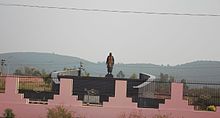Janaki Ballabh Patnaik | |
|---|---|
 Patnaik in 2009 | |
| 25th Governor of Assam | |
| In office 11 December 2009 – 10 December 2014 | |
| Chief Minister | Tarun Gogoi |
| Preceded by | Syed Sibtey Razi |
| Succeeded by | Padmanabha Acharya |
| 11th Chief Minister of Odisha | |
| In office 15 March 1995 – 17 February 1999 | |
| Preceded by | Biju Patnaik |
| Succeeded by | Giridhar Gamang |
| In office 9 June 1980 – 7 December 1989 | |
| Preceded by | Nilamani Routray |
| Succeeded by | Hemananda Biswal |
| Union Minister of Tourism, Civil Aviation and Labour | |
| In office 16 January 1980 – 7 June 1980 | |
| President of Indian Youth Congress, Odisha state unit | |
| In office 1950–n/a | |
| Personal details | |
| Born | 3 January 1927 Rameshwar, Bihar and Orissa Province, British India |
| Died | 21 April 2015 (aged 88) Tirupati, Andhra Pradesh, India |
| Political party | |
| Spouse | Jayanti Patnaik |
| Alma mater | |
| Website | Official website |
Janaki Ballabh Patnaik (3 January 1927 – 21 April 2015) was an Indian politician who had been 25th Governor of Assam from 2009 to 2014.[1] A leader of the Indian National Congress, he was Chief Minister of Odisha from 1980 to 1989 and again from 1995 to 1999, holding that post for the longest time on record before Naveen Patnaik. In 1950, he became the President of the Odisha state unit of the youth wing of the Congress. In 1980, he became the Union Minister for Tourism, Civil Aviation and Labour from 16 January to 7 June.
Personal Life
[edit]He was born in a well known Karan family.[2]
Controversy
[edit]He was involved in the Anjana Mishra rape case.[3][4]
Death
[edit]
He died on Tuesday, 21 April 2015, aged 88 at Tirupati in Andhra Pradesh. On Monday, 20 April 2015, he had gone to attend the convocation of Rashtriya Sanskrit Vidyapeetha, of which he was chancellor, and also visited the Lord Venkateswara Temple, Tirumala.[5][6][1] Later in the night, he complained of severe chest pain and was subsequently shifted to Sri Venkateswara Institute of Medical Sciences (SVIMS) where he died at around 3:00 am. on 21 April. He leaves behind a legacy of having translated the Mahabharata, the Ramayana and the Bhagavad Gita into his mother tongue, as he was a Sanskrit-Odia scholar.[7]
References
[edit]- ^ a b "PM Modi condoles the Death of former Orissa CM Janaki Ballabh Patnaik". news.biharprabha.com. 21 April 2015. Retrieved 21 April 2015.
- ^ "Reign of Patnaiks: 40 years and counting". The Times of India. 13 April 2019. ISSN 0971-8257. Retrieved 15 September 2024.
- ^ "My story BY ANJANA MISHRA". The Week. 7 February 1999.
- ^ Nilanjana Bhaduri Jha (18 August 2006). "System insensitive, says rape victim". Times of India.
- ^ Former Odisha CM J B Patnaik passes away at 89
- ^ Janaki Ballabh Patnaik cremated in Puri
- ^ "Former Assam Governor J.B. Patnaik passes away". myinfoindia. 21 April 2015. Retrieved 21 April 2015.